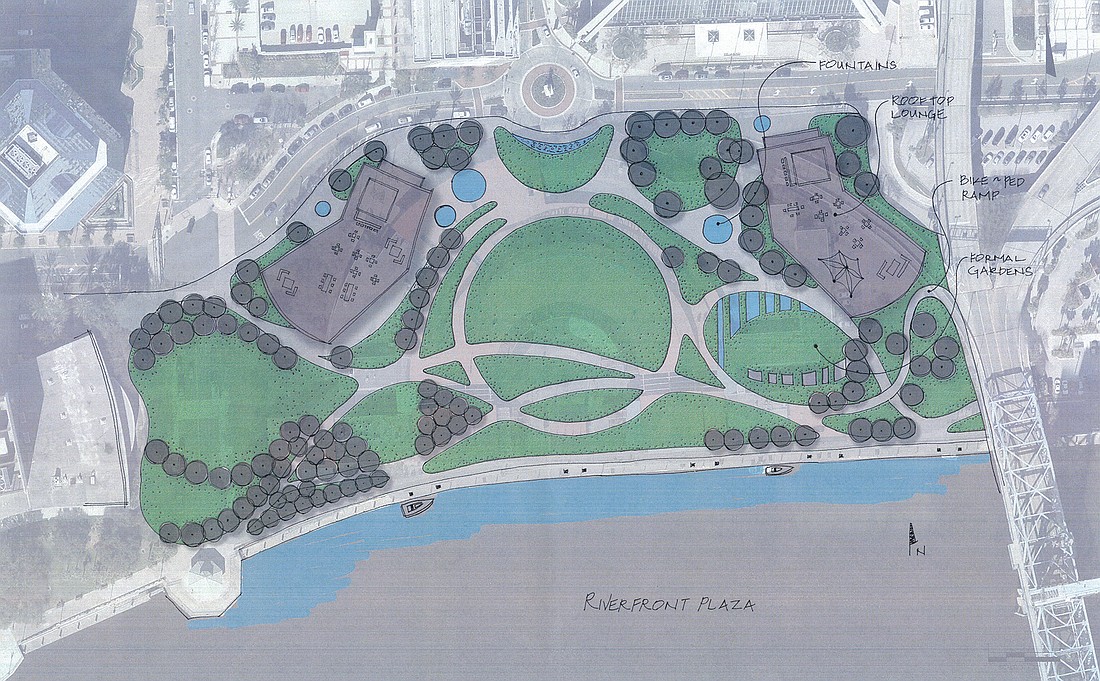
The city of Jacksonville now has complete ownership of The Jacksonville Landing and all but three of the tenants have until June 1 to move out of the riverfront shopping mall.
Negotiations are underway with BBVA Compass bank, Hooters Restaurant and Fionn MacCool’s Irish Pub and Restaurant for their departure.
Despite demolition detractors, Mayor Lenny Curry and City Council legislation enacted March 26 have given the go-ahead to the city’s Department of Public Works to demolish the structure in favor of a more open, active riverfront development.
So when will it come down?
With Ordinance 2019-134 allotting $1.5 million to demolish the Landing, a request for proposals to tear it down could be released from the City’s Public Works Department any time.
Curry’s Chief of Staff Brian Hughes said Tuesday he hopes to see a request for proposals for demolition come out of Public Works within eight to 10 weeks.
Most of the 26 remaining tenants held short-term, month-to-month leases and will be out of the Landing by June 1. When demo can begin largely will depend on legal negotiations with long-term tenants BBVA, Hooters and Fionn MacCool’s.
Attorneys for each of the three businesses and the city are talking now, trying to expedite their exits.
As the landlord, the city has certain legal obligations to the bank and restaurants, including keeping the building in a condition where the businesses can stay operational.
That doesn’t mean demolition won’t begin.
BBVA Compass is in the eastern part of the main building. Fionn MacCool’s is in another eastern building while Hooters is on the riverfront in a western building.
Hughes said the negotiations could allow for a phased demolition of the Landing.
If one of the businesses vacates, whether on the west or east side, the city likely will begin partial demolition of the structure in less than six months. That could allow developers to start work on at least part of the property.
“If there is an isolated area in the Landing that can be demoed without it impacting the legal requirement for any other tenant that’s remaining, that could begin,” Hughes said.
A phased demolition, Hughes said, also could speed up a Florida Department of Transportation decision to remove the adjacent Main Street Bridge on-ramp.
Curry wants to use that parcel for development and easier pedestrian and bicycle access to future public space at the Landing site.
“The reason we would phase the demo is to have a clear indication that we can demo the on-ramp — to demonstrate to (F)DOT we’re doing what we said here, so let’s get to the ramp and have that parcel ready to develop and have a sense of what the interests and economics of developable pads are,” Hughes said. “We can then do that math on the public activation.”
Design and redevelopment
The land is owned by the city. Because it is within a Community Redevelopment Area, any design and redevelopment for the Landing will be under the jurisdiction of the Downtown Investment Authority.
Hughes is the interim DIA CEO and becomes Curry’s Chief Administrative Officer when Sam Mousa retires June 28.
Hughes doesn’t expect a design process to begin before July. By then, there will be a new DIA CEO, possibly with a different perspective on the site’s future.
A DIA board, appointed by former Mayor Alvin Brown, who served from 2011-15, undertook a $100,000 design process with Atlanta-based Wakefield Beasley & Associates and Urban Design Associates that incorporated six public input sessions.
Lawsuits with former Landing owner Jacksonville Landing Investments Landing LLC stopped the public unveiling of the final plan.
Hughes has since released the 2015 development renderings to prove to incoming council member Matt Carlucci and other critics that a public charrette process on Landing redevelopment already has been done.
Now that the 2015 drawings were released last week, it will be up to the current DIA board whether to incorporate all or part of the Wakefield Beasley design or start over.
Both the more detailed 2015 design and the simplified Public Works sketch released last year show the same concept — two bifurcated developable pads with activated green space.
“The discussion points are about how much green, how much hardscape, how many trees, where is the art, how big are the pads that are developable (and) what are the economics behind that,” Hughes said.
As demolition clears the Landing, Hughes made it clear Tuesday he doesn’t see the areas intended for private development staying in public ownership for long.
“If we’re going to bifurcate and lay out two developable pads, it probably makes a lot of sense to convert that to private ownership so that it generates property taxes which would allow for (Recapture Enhanced Value) grants. There would also be a balance left over in that tax bill, which we can’t give as REV grants, that I think it would be a very clear indicator of what sustains the new public space,” Hughes said.
The chief of staff said the best possible time frame from completion is “ASAP.” Curry wants the Landing redevelopment to move quickly.
Although the design will be in the DIA’s court, it’s clear Curry’s voice will be a looming presence in the Landing’s fate.